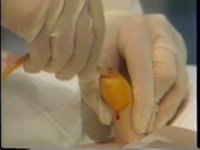by. Siswanto M. Muhammad

I. General intructions
1. Asses The Patient
- Identify the patient and explain the procedure
- Check the patient's general condition for any contraindication
- Reassure the patient
2. Plan the Procedure
- Make sure that you know the procedure well
- seek assistance, if required
- Wash and dry hand before and after each procedure whenever needed
- Collect all equipment required for the procedure before going the patient.
3. Perform the Procedure
- Provide privacy by screening, draping and closing doors and windows
- Ensure that visitor are not present during the procedure, unless atherwise indicated.
- Adjust the room temperature and lighting
- Position according to the procedureand the patient's condition.
- Wear protective gown, mask, gloves, etc if needed.
- Involve the patient in his care to encourage communication and participation.
- Ensure patient's safety (e,q, said rail up, call bell is within reach; etc)
- Deal with used articles and wastes according to infection control policy.
4. Evaluate The Procedure
- Check the patient's condition
- Record and report relevant finding immediately
- Give specific instruction to the patient.
II. Catheterization of Male Patient
1. Purpose :
- To relieve acute or chronic urinary retention
- For preoperative urinary drainage
- To determine amount of residual urine after voiding
2. Equipment :
- Sterile gloves
- Disposible sterile catheter set with sigle use packet of lubricant
- Antiseptic solution for Peri urethral cleansing
- Gloves,sponges, drapes
- Urine bag, sterile container for culture.
3. Procedure and Rationale
A. Preparatory Phase :
- Put the patient at ease
- Rational :The patient will feel reasured if the procedure is expalined and if he is handed gently and considerably.
- Open catheter tray using aseptic technique, place waste receptacle in accessible place.
- Rational : Catheterization requires the same aseptic precaution as a surgical procedure, the principle danger of catheterization is urinary tractus infection, which is associated with increased morbidity and longer, more costly hospitalization.
- Place the patient in supine position with legs extended, place the moisture proof pad across uper thighs.
- Wash hands, put on sterile gloves.
B. Performance Phase :
- Lubricate the catheter well with lubricant or prescribe topical anesthetic.
- Rational : A well lubricated catheter prevent urethral trauma, decreasing the opportunity for bacterial invasion.
- Wash of glans penis around urinary meatus with the iodophor solution (bethadine) using forceps to hold cleansing sponges. Keep the foreskin retracted. Maintain sterility of dominant hand.
- Rational :Cleanse urethral meatus form tip to foreskin with downward stroke on one side, discard sponge, repeat as required.
- Grasp shaft of penis (with non dominant hand and elevate it, apply gentle traction to penis while catheter is passed)
- Rational : This manuever straightens the penile urethra and facilitates catheterization, maintaning a grasp of the penis prevent contamination and retraction of penis.
- Using sterile gloves or forceps, insert catheter into the urethra, advance catheter 15-25 cm (6-10 inches) until urine flows.
- Rational : The male urethra is a canal extending from the bladder to the end of the glans penis. The lenght varies within wide limith; the everage length is about 21 cm.
- If resistance is felt at the external sphincter, slightly increase the traction on the penis and apply gentle pressure on the catheter, ask patient to stain gently (as if passing urine) to help relax sphincter.
- Ratioal : Same resistance maybe due to spasm of external sphincter, inability to pass the catheter may mean that a urethral stricture or other form of urethral pathology exist, the urethra may have to be dilated with sound by urologist.
- When urine begins to flow, advance the catheter another 2,5 cm (1 inch)
- Rational : Advancing the catheter ensure it is position in the bladder.
- Reduce or reposition the foreskin
C. Follow UP Phase :
- Dry area, make patient comfortable
- Measure urine and dispose of equipment
- Send specimen to laboratory as indicated
- Record time, procedure, amount and appearance of urine.
#References :
* Dolores F. Saxton, Comprehensive Review Of Nursing For NCLEK-RN, Sixteenth
Edition, Mosby, St. louis, Missouri, 1999.
* The lippincott Manual of Nursing Practice, 7th Edition, 2005.
* Nursing Procedures, Springhouse Publishing Co, 3rd, ed, Mosby, 2000
* Pediatric Nursing Procedures, Vicky R.Bowden and Cindy Smith Greenbers, Lippincott
Williams and Wolkins Publisher, 2003.


No comments:
Post a Comment